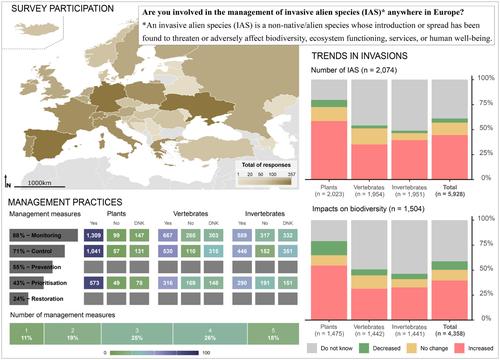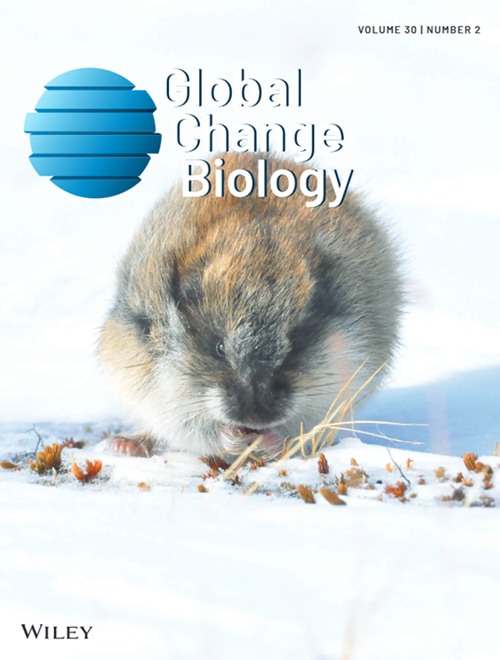Management Measures and Trends of Biological Invasions in Europe: A Survey‐Based Assessment of Local Managers
IF 10.8
1区 环境科学与生态学
Q1 BIODIVERSITY CONSERVATION
引用次数: 0
Abstract
Biological invasions are a major threat to biodiversity, ecosystem functioning and nature's contributions to people worldwide. However, the effectiveness of invasive alien species (IAS) management measures and the progress toward achieving biodiversity targets remain uncertain due to limited and nonuniform data availability. Management success is usually assessed at a local level and documented in technical reports, often written in languages other than English, which makes such data notoriously difficult to collect at large geographic scales. Here we present the first European assessment of how managers perceive trends in IAS and the effectiveness of management measures to mitigate biological invasions. We developed a structured questionnaire translated into 18 languages and disseminated it to local and regional managers of IAS in Europe. We received responses from 1928 participants from 41 European countries, including 24 European Union (EU) Member States. Our results reveal substantial efforts in IAS monitoring and control, with invasive plants being the primary focus. Yet, there is a general perception of an increase in the numbers, occupied areas, and impacts of IAS across environment and taxonomic groups, particularly plants, over time. This perceived increase is consistent across both EU and non‐EU countries, with respondents from EU countries demonstrating more certainty in their responses. Our results also indicate a lack of data on alien vertebrates and invertebrates, reflecting a need for more targeted monitoring and knowledge sharing between managers and policymakers and between countries. Overall, our study suggests that Europe's current strategies are insufficient to substantially reduce IAS by 2030 and hence to meet the Kunming‐Montreal Global Biodiversity Framework target.

欧洲生物入侵的管理措施和趋势:基于当地管理者的调查评估
生物入侵是全球生物多样性、生态系统功能和自然对人类贡献的重大威胁。然而,由于数据有限和不统一,外来入侵物种管理措施的有效性和实现生物多样性目标的进展仍然不确定。管理的成功通常在地方一级进行评估,并记录在技术报告中,这些报告通常用英语以外的语言编写,这使得在大范围的地理范围内收集此类数据非常困难。在这里,我们提出了第一个欧洲评估管理者如何感知IAS趋势和管理措施的有效性,以减轻生物入侵。我们编制了一份被翻译成18种语言的结构化问卷,并将其分发给欧洲国际会计准则的当地和区域经理。我们收到了来自41个欧洲国家的1928名与会者的答复,其中包括24个欧洲联盟(EU)成员国。我们的研究结果表明,对入侵植物的监测和控制是主要的重点。然而,人们普遍认为,随着时间的推移,IAS的数量、占用面积和对环境和分类群体(特别是植物)的影响都在增加。这种感知到的增长在欧盟和非欧盟国家都是一致的,来自欧盟国家的受访者在他们的回答中表现出更大的确定性。我们的研究结果还表明,缺乏外来脊椎动物和无脊椎动物的数据,这反映了管理者和决策者之间以及国家之间需要更有针对性的监测和知识共享。总体而言,我们的研究表明,欧洲目前的战略不足以在2030年之前大幅减少IAS,从而实现昆明-蒙特利尔全球生物多样性框架的目标。
本文章由计算机程序翻译,如有差异,请以英文原文为准。
求助全文
约1分钟内获得全文
求助全文
来源期刊

Global Change Biology
环境科学-环境科学
CiteScore
21.50
自引率
5.20%
发文量
497
审稿时长
3.3 months
期刊介绍:
Global Change Biology is an environmental change journal committed to shaping the future and addressing the world's most pressing challenges, including sustainability, climate change, environmental protection, food and water safety, and global health.
Dedicated to fostering a profound understanding of the impacts of global change on biological systems and offering innovative solutions, the journal publishes a diverse range of content, including primary research articles, technical advances, research reviews, reports, opinions, perspectives, commentaries, and letters. Starting with the 2024 volume, Global Change Biology will transition to an online-only format, enhancing accessibility and contributing to the evolution of scholarly communication.
 求助内容:
求助内容: 应助结果提醒方式:
应助结果提醒方式:


